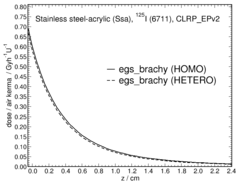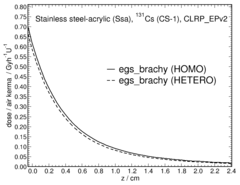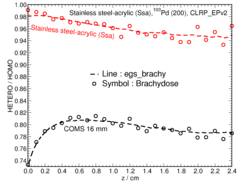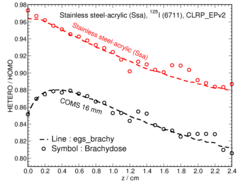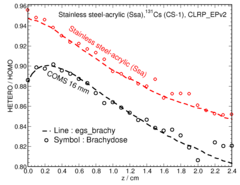

Eye Plaque Description
The dimensions of the "Stainless steel-acrylic" (Ssa) eye plaque are available here (given in the TG-221 report 1 and Lesperance et al study 2). The plaque has indentations for 13 seeds within Acrylic insert (seed coordinates here) in the Stainless steel backing, as shown in the above figures (generated using egs_view). The 3D dose distributions for the plaque containing 125I (6711), 103Pd (200), and 131Cs (CS-1 Rev2) (Ref. 3) are provided here (normalized per unit seed air kerma strength):
-
HOMO (13 seeds modelled under TG43 conditions) and HETERO (fully-loaded eye plaque in water) for 103Pd: Zipped archive
-
HOMO (13 seeds modelled under TG43 conditions) and HETERO (fully-loaded eye plaque in water) for 125I: Zipped archive
-
HOMO (13 seeds modelled under TG43 conditions) and HETERO (fully-loaded eye plaque in water) for 131Cs: Zipped archive
Central axis depth dose curves
Doses along the plaque's central z-axis (CAX) for HOMO and HETERO scenarios are presented here for three radionuclides. Overall, HETERO doses are slightly lower than HOMO doses, due to the small photon attenuation and scattering in the plaque backing and insert. For instance, HETERO/HOMO dose ratio at 0.5 cm along the CAX is 0.97, 0.94, and 0.92, for 103Pd, 125I, and 131Cs, respectively.
HETERO/HOMO dose ratio along the CAX
HETERO/HOMO dose ratio along the CAX are presented here for three radionuclides. The mean values of HETERO/HOMO doses along the CAX were 0.96 for 103Pd, 0.92 for 125I, and 0.89 for 131Cs, respectively. These corresponding values for COMS 16 mm were 0.79, 0.85, and 0.85, respectively. The mean (range) percentage difference of HETERO/HOMO doses between egs_brachy and BrachyDose 1 were 0.05% (-1.6%, 1.4%) for 103Pd, -0.37% (-1.8%, 1.3%) for 125I, and -0.34 (-1.5%, 0.27%) for 131Cs, respectively. The corresponding values for COMS 16 mm were 0.06% (-1.1%, 1.4%) for 103Pd, -0.10% (-1.3%, 0.82%) for 125I, and -0.12% (-2.2%, 2.0%) for 131Cs, respectively. Statistical uncertainties for egs_brachy, and BrachyDose 1,2 have been < 0.2% and 1.0%, respectively.
Transverse dose profile
HOMO and HETERO transverse dose profiles (along x and y axes) at depths of z = 0.5 cm and z = 1 cm are shown for three radionuclides.
103Pd, x view, z =0.5 and 1 cm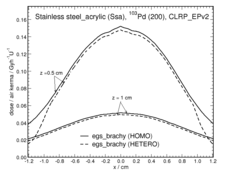 |
103Pd, y view, z =0.5 and 1 cm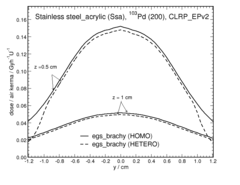 |
125I, x view, z =0.5 and 1 cm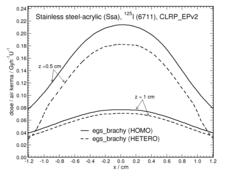 |
125I, y view, z =0.5 and 1 cm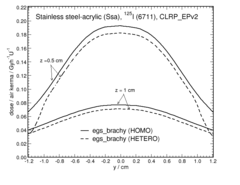 |
131Cs, x view, z =0.5 and 1 cm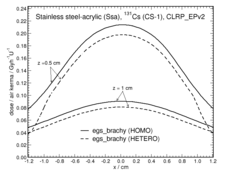 |
131Cs, y view, z =0.5 and 1 cm |

